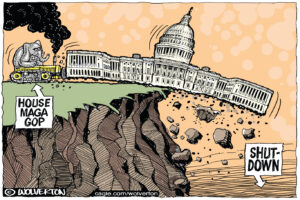In Need of a Watchdog on Health Spending
There was a nice, albeit fleeting, moment in the spring when hospitals, doctors, drug companies and insurers came together at the White House, pledging to do their part to get health care costs under control.Help wanted: Brave senator or senators willing to champion amendment creating fail-safe mechanism to control health care spending. Bipartisan coalition preferred; will consider Democrats-only group, preferably with track record on fiscal responsibility. Must be willing to take on drug companies, hospitals, doctors and other providers. Experience in withstanding negative advertising a plus.
There was a nice, albeit fleeting, moment in the spring when hospitals, doctors, drug companies and insurers came together at the White House, pledging to do their part to get health care costs under control. These key players were so serious they were willing to attach numbers to their rhetoric. They promised to shave an average of 1.5 percentage points annually off the growth rate of health care costs, saving a total of $2 trillion over 10 years from projected spending.
Just one thing was missing — and still is: any way to enforce those noble intentions. Most of these players balked at the suggestion that their pledge be codified. But if these savings are achievable, as the industries have already agreed they are, why not?
The administration’s dual selling points for health reform were that it would simultaneously expand coverage and bend the inexorably rising curve of spending. The first part is important and easy to do. The second is arguably more important and excruciatingly difficult to achieve.
A recent analysis of the Senate proposal by Richard Foster, the chief actuary for the Medicare program, offers a sobering demonstration of this reality. If the Senate measure were to become law, Foster concludes, overall health care spending would increase by 0.7 percent, or $234 billion, over 10 years. The House measure, according to Foster’s analysis, would drive up spending slightly more, by $289 billion.
It’s possible to read the report in a more hopeful light. By 2019, Foster estimates, national health care costs will be growing at an annual rate of 6.9 percent, compared to 7.2 percent in the absence of reform. A welcome degree of curve bending — if it persists. That’s a big if. The trend line for spending growth under health reform at the end of the decade is rising, and the gap between spending increases with and without health reform is narrowing.
Which leads to the even scarier part of Foster’s assessment: that a good chunk of the promised savings in Medicare is likely to be illusory. The Senate measure envisions cutting projected Medicare spending by nearly $500 billion. Almost half those savings, however, would come from cutting provider payments to an extent that Foster says is “unlikely to be sustainable on a permanent annual basis.”
Maybe Foster is too pessimistic. A new study from the Center for American Progress and the Commonwealth Fund estimates overall savings from health reform of $683 billion over 10 years, with average growth slowed to 6 percent.
The study’s authors say the analyses by Foster and the Congressional Budget Office fail to give enough credit to the savings that could be achieved by cutting administrative costs and changing payment methods to reward better care.
Let’s hope the higher savings materialize — but include a backup plan if they don’t. The Senate measure already contains a mini-version of such an approach: A new Independent Medicare Advisory Board that would recommend changes, subject to an up-or-down congressional vote, if costs grow faster than a pre-set target. Virginia Democratic Sen. Mark Warner has usefully proposed expanding the board’s mandate to include recommendations for controlling private-sector health costs — though these, unlike the Medicare proposals, would not have a fast track to congressional approval.
An inescapable lesson of the health reform debate is how difficult it is to change just one part of the system; squeeze Medicare, for example, and costs shift elsewhere, cuts are undone, access is reduced.
Lawmakers should embrace the Warner proposal and beef it up to give the board real power, not just the ability to make suggestions that sit on a shelf. It could set spending targets, report on what sectors of the industry are failing to contain costs — and, if all else fails, propose steps to get costs under control. For example, hospitals whose prices rise too quickly, or insurers with excessive administrative costs, could be excluded from participating in the new insurance exchanges.
The wispy promises of spring were lovely. December is the time for them to be etched in the cold language of legislation.
Ruth Marcus’ e-mail address is marcusr(at symbol)washpost.com.
© 2009, Washington Post Writers Group
Your support matters…Independent journalism is under threat and overshadowed by heavily funded mainstream media.
You can help level the playing field. Become a member.
Your tax-deductible contribution keeps us digging beneath the headlines to give you thought-provoking, investigative reporting and analysis that unearths what's really happening- without compromise.
Give today to support our courageous, independent journalists.






You need to be a supporter to comment.
There are currently no responses to this article.
Be the first to respond.